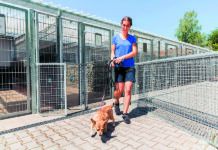Pain after abdominal surgery
Q My dog is supposed to undergo abdominal surgery, but I am worried about the aftermath. When my father had abdominal surgery, he was so tender at the spot that it took at least six weeks before he was able to walk again without pain. I hate to put my dog through that, but I know he needs the operation. He’s a very active dog. How will I be able to keep him still for all those months so he doesn’t keep over-extending himself and getting hurt?
Jordan Webb
Manhasset, New York
Dear Mr. Webb,
A You needn’t be as concerned as you are. This is one case in which it’s not quite the same for dogs as for people. Consider that when a person stands up to walk, he stands on two legs only and has to use his abdominal muscles to keep from tipping over. Because a dog walks on all four limbs instead of two, his legs do all the balancing and spare the abdomen any exertion. All the abdominal muscles have to do is hold in the dog’s organs, not expand and contract every single time the dog takes a step. In other words, cutting through a dog’s abdominal muscles to get to whatever organ needs to be operated on won’t hinder his mobility. He’ll be up and around pretty quickly. How quickly?
Generally, he’ll be walking the day of the surgery and back to his normal self within a week to 10 days. Go ahead and schedule the operation with a lighter heart.
Dog-on-dog fun
Q I appreciated your article last month about dogs who don’t like other dogs. But I’m still confused about full-on aggression resulting from fear versus rough-and-tumble play. Sometimes my dog gets going with another dog, and it looks out-and-out scary. They’ll growl and even bite each other, then they’ll pause for what seems like a micro-second and go back for more. Neither dog will come away worse for the wear, but it does seem frightening. Is my dog fighting or playing?
Madeleine Drefuss
Newark, Deleware
Dear Ms. Drefuss,
A We understand your concern. Sometimes it does look for all the world that two dogs are going to do real harm to each other. But part of the clue about why you should feel relaxed about this behavior is in your question. Dog play has pauses in it. They can be very short pauses, to be sure. Pause and assess, pause and assess, then back at it. When it’s a real fight, on the other hand, there’s no taking a breath, no assessing. The aim is to vanquish the enemy.
Something else to look for is mutuality. If the two dogs are not of the same mind and a fight is going on, one dog will be acting at least somewhat differently from the other. As an example, he may be trying to get away as the other dog comes after him. But if it’s more like, I chase you, then you chase me, the two dogs feel friendly toward each other. That’s true even if they jump on each other and use their teeth to nip and make growling sounds. As long as there’s a periodic pause, and as long as they both appear happy, chances are things are okay.
If the two dogs are different in size, you’ll also want to look for modulation of behavior. In play, the larger dog will get down low to be on the same level as the littler one, and he will also allow the smaller dog to attack him harder than he attacks back.
Keep in mind, too, that playing comes with initiation behavior. Dogs who feel okay about each other will approach in an arc-like fashion, from the side, rather than run straight on, which is a threat tactic. They’ll sniff each other, too, usually starting at the back end. Sniffing the face first is seen as rude, bossy. And they may also give a play bow or at least lie still with their front feet splayed in front of them before charging forward. True aggression, on the other hand, doesn’t come with any polite body language to start the fight. If two dogs are really going to put up their dukes, there’s no Marquis of Queensbury rules to depict polite sportsmanship before the aggression begins.




